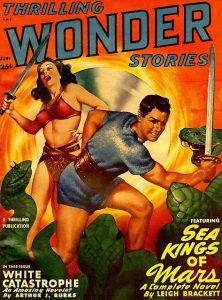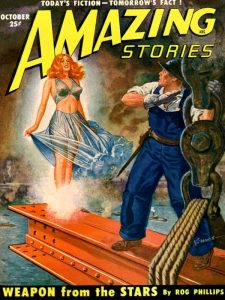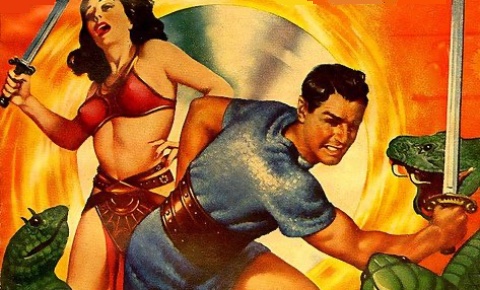 August 22, 2020 will be the 100th anniversary of author Ray Bradbury’s birth. With that occasion very much in mind, PulpFest 2020 plans to celebrate the centennial of the author’s birth as part of its salute to “Bradbury, BLACK MASK, and Brundage.”
August 22, 2020 will be the 100th anniversary of author Ray Bradbury’s birth. With that occasion very much in mind, PulpFest 2020 plans to celebrate the centennial of the author’s birth as part of its salute to “Bradbury, BLACK MASK, and Brundage.”
So what better way is there to start the party than by talking about Ray Bradbury’s much lauded fix-up novel . . .
THE MARTIAN CHRONICLES
The first story to be published from THE MARTIAN CHRONICLES is the “The Million Year Picnic” (PLANET STORIES, Summer 1946). Appearing last in Bradbury’s book, the tale isn’t about Martians at all. . . . At least, not at first. Its readers eventually discover a whole new race of Martians. You’d recognize one of them if you looked in a mirror.
THE MARTIAN CHRONICLES constructs a complex pastiche of Mars, as imagined by Ray Bradbury. Many of the stories are melancholic, wistful. The book’s Martians are frequently dangerous, but not in ordinary ways. In “The Earth Men” (THRILLING WONDER STORIES, August 1948) the first humans to land on Mars are taken for madmen. They end up in a Martian insane asylum and are considered incurable.
Bradbury’s Martians are telepathic. This adds an unusual twist to their defense against colonization and invasion. In “Mars is Heaven!” (PLANET STORIES, Fall 1948), the Martians use telepathic trickery to convince the astronauts that they’ve returned home. The visitors are shown familiar sights and loved ones, long dead. This keeps the Earthmen off guard until it’s too late. They are killed. One wonders if Bradbury’s telepathic Martians are simply too sensitive to bear human contact.
In “Impossible” (SUPER SCIENCE STORIES, November 1949), a shape-shifting Martian is “caught” by the thoughts of the human settlers. The Martian is forced to change shape again and again, according to the whims of the nearest mind. Most of the humans, greedy for the apparent resurrection of their departed loved ones, care little for the being that is tortured by their thoughts. The Martian eventually dies from their callousness. The story was retitled, “The Martian,” for its appearance in THE MARTIAN CHRONICLES.
Ray Bradbury’s vision isn’t a simple or happy one. In many ways his stories are well ahead of their time, contemplative and complex, rather than seat-of-the-pants pulp adventures. Bradbury himself called them fantasies and not science fiction:
“I don’t write science fiction. Science fiction is a depiction of the real. Fantasy is a depiction of the unreal. So MARTIAN CHRONICLES is not science fiction, it’s fantasy. It couldn’t happen, you see?”
By this definition, most of the pulp era’s Mars stories should be considered fantasy. They are certainly unreal, encompassing everything from Bug-Eyed Monsters to sword and sandal epics. The red planet is a screen onto which dreams are projected, much like Edgar Rice Burroughs projected John Carter across space to take up his new life on Barsoom, his Martian’s name for Mars.
A Land of Myth and Legend
Many who wrote after Burroughs describe human-like Martians that are slightly different from Earthly humans. However, they are not so different that a love story can’t ensue. Sometimes, the resemblance is so close that a Martian may come to Earth and live as human.
Such is the case in Edmond Hamilton’s “The Prisoner of Mars” (STARTLING STORIES, May 1939). In this novel, a lost Martian prince, born on Earth and with no knowledge of his extraterrestrial heritage, ends up returning to his home planet and saving both worlds.
In “Shambleau” (WEIRD TALES, November 1933), Catherine Lucille Moore’s gun-for-hire, Northwest Smith, has a fateful encounter with a malevolent entity in a seedy Martian colony city. The ancient creature met by Smith is not a Martian, but resembles both a vampire and Medusa. It attacks in an appropriately chilling way.
In Leigh Brackett’s story, “Sea-Kings of Mars” (THRILLING WONDER STORIES, June 1949), Matt Carse unluckily stumbles into Mars’ distant past and becomes possessed by an ancient and powerful god. When published in paperback by Ace Books in 1953, Brackett’s story would be called THE SWORD OF RHIANNON.
In Bryce Walton’s “Man of Two Worlds” (SPACE STORIES, October 1952), the Earthman hero, Lee Thorsten, becomes trapped in a time loop on Mars that reveals him to be a hero from Earth’s ancient mythical past.
Unhuman Monsters
Not all Mars stories are sword and sandal adventures in the Burroughs tradition. Some follow the model established by H.G. Wells’s THE WAR OF THE WORLDS. In “The Human Pets of Mars” by Leslie F. Stone (AMAZING STORIES, October 1936), gigantic alien invaders — true Bug-Eyed Monsters — arrive on Earth. They have come to collect specimens (including a dog and a horse) to take back to Mars as pets. Whereas a more modern story might play this for laughs, Stone is quite serious in her commentary about human nature.
We also see unhuman Martians in both “A Martian Odyssey,” by Stanley G. Weinbaum (WONDER STORIES, July 1934), and Raymond Z. Gallun’s “Old Faithful” (ASTOUNDING STORIES, December 1934). In them, we see weird beings that are not at all human. However, the Martians in these two classics are helpful aliens and not hostile. In 1970, when the Science Fiction Writers of America voted on the best science fiction short stories to be published before the advent of the Nebula Award, “A Martian Odyssey” came in second behind Isaac Asimov’s “Nightfall.”
Death and the Afterlife
 In several accounts, Mars is related to the afterlife. If not our Heaven, then a Martian version instead. In both “Seven Came Back,” by Clifford D. Simak (AMAZING STORIES, October 1950), and “The Mating of the Moons,” by Bryce Walton — writing as Kenneth O’Hara — (ORBIT SCIENCE FICTION, December 1953), we see a paradisiacal land only accessible to humans when access is granted through an act of service or by some other resonance with the Martians.
In several accounts, Mars is related to the afterlife. If not our Heaven, then a Martian version instead. In both “Seven Came Back,” by Clifford D. Simak (AMAZING STORIES, October 1950), and “The Mating of the Moons,” by Bryce Walton — writing as Kenneth O’Hara — (ORBIT SCIENCE FICTION, December 1953), we see a paradisiacal land only accessible to humans when access is granted through an act of service or by some other resonance with the Martians.
This connection to the dead and the dying leads us to back to Bradbury’s celebrated work, THE MARTIAN CHRONICLES. Although the stories are diverse, the overarching feeling is melancholia for a worn and tired ancient world, slowly crumbling to bits amidst the red planet’s cold desert sands.
Please join PulpFest 2020 on Thursday, August 8, as we welcome Sara to discuss these and other pulp visions of the planet Mars at the DoubleTree by Hilton Hotel Pittsburgh – Cranberry in Mars, Pennsylvania. It’s the second part of our series exploring “Visions of Mars,” celebrating the 100th anniversary of the birth of author Ray Douglas Bradbury.
(Sara Light-Waller is a writer, illustrator, and avid pulp fan. Science fiction pulps are her favorites, especially space opera and thought variant stories. The Grand Prize winner of the 2020 Cosmos Prize — offered by First Fandom Experience for the best ending to the seventeen-part round-robin story that began in June 1933 — Sara has also published two illustrated New Pulp books with more to come. Catch up with her at Lucina Press where you can learn about her work and so much more.
Earle K. Bergey painted the cover art for the June 1949 THRILLING WONDER STORIES, one of many paintings he created for Standard Magazines’ science fiction line. Bergey’s art illustrates Leigh Brackett’s “The Sea-Kings of Mars.”
Although Robert Gibson Jones’s cover art for the October 1950 AMAZING STORIES is certainly not set on Mars, the issue features the Clifford D. Simak story, “Seven Came Back.” A reading of this exceptional short story suggests that it was inspired by Bradbury’s THE MARTIAN CHRONICLES and the P. Schuyler Miller story, “The Cave,” published in the January 1943 number of ASTOUNDING SCIENCE-FICTION. Simak’s tale was later reprinted in the May 1966 FANTASTIC.
For a look at our entire programming schedule, please click the Programming button below the PulpFest banner on our home page.)







